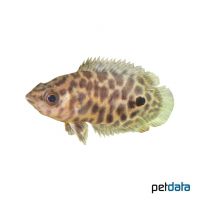Leopard Bushfish (Ctenopoma acutirostre)
| Leopard Bushfish Ctenopoma acutirostre | |
|---|---|
| Name | Leopard Bushfish |
| Name Lat. | Ctenopoma acutirostre |
| Family | Climbing Gouramies |
| Family lat. | Anabantidae |
| Order | Labyrinth Fishes |
| Order lat. | Anabantiformes |
| Origin | Congo |
| Habitat | Rivers, ponds |
| Diet | Carnivore |
| pH | 6.0-7.5 |
| Behavior | Predatory |
| Keeping | Pair, group |
| Care Level | Difficult |
| Reproduction | Egg scatterer |
| Breeding | Difficult |
| Life Span | 8-15 years |
| Protection | No |
| Metric Units | |
| Size | 10-15 cm |
| Temperature | 23-27 °C |
| Hardness | 2-12 °dH |
| Aquarium | ~ 250 l |
| US Units | |
| Size | 4"-6" |
| Temperature | 73-81 °F |
| Hardness | 36-214 ppm |
| Aquarium | ~ 65 gal |
Distribution and habitat
The range of the crepuscular leopard bushfish is the river system of the middle Congo. They live in slow-flowing to stagnant waters, with dense underwater vegetation, where they like to stay in the shelter of plants growing over the bank.
Maintenance
They require an aquarium with dense planting and roots that provide numerous hiding places as well as sufficient swimming space. A dark sandy substrate covered with some foliage, subdued light (e.g. floating plant cover), clear water and a weak current is ideal.
No ammonia, ammonium and nitrite should be detectable, the nitrate value should not exceed 100 mg/l. To ensure the water quality and oxygen content, a filter and heater adapted to the aquarium size is required, as well as lighting for the species-appropriate day-night rhythm of the animals.
Diet
They are predatory ambush hunters. According to their size, the food offer consists of artemia, mysis, black mosquito larvae, shrimps, krill, mussel meat, etc., which is also accepted without problems in frozen form, occasionally supplemented with live earthworms or meal beetle larvae. After habituation, sometimes also high-quality, protein-rich dry food (granules, pellets) is accepted
Only as much should be fed as is eaten within a few minutes. Regular and varied feeding promotes health and increases resistance.
Behaviour and compatibility
These shy, hidden animals should be kept in pairs or in a group. To avoid turf wars, one group should be introduced into the aquarium at a time. Group keeping is only recommended in a larger richly structured tank. They can be kept well with other calm fish, such as African tetras and barbs. Fish that are too small are considered food. Basically, only compatible fish species with similar water condition and water temperature requirements should be socialized.
Sex dimorphism
The sexes are very difficult to distinguish. Males have more spines on the gill covers and a coarser textured pattern at the base of the caudal fin than females.
Reproduction and breeding
There are only isolated reports of successful breeding in the aquarium. The male wraps around the female and the eggs swim to the water surface covered with floating plants. There is no brood care. After about 48 hours, the fry hatch and swim freely. It is important that the fry have warm moist air to breathe between the water surface and the aquarium cover.
Fry must be fed several times a day with special rearing food (Artemia nauplii). In a community tank breeding is hardly possible, because the fry are easy prey.
Important
They have an additional respiratory organ, the so-called labyrinth (suprabranchial organ) with which they breathe atmospheric air and can suffocate if this is not possible. The air temperature in the breathing area must not be below the water temperature!
The aquarium must be well covered, as they occasionally jump. When catching, use as fine-meshed nets as possible (better vessels), so that the spines do not get caught on the body.
The well-being of the fish should be checked regularly. The temperature should be checked daily, the pH, hardness and nitrate value at least every 14 days. Regular partial water changes are recommended, even if the pollutant level has not yet reached the upper limit. Sudden changes in water quality should be avoided. Newly introduced fish must be accustomed slowly to the water in the aquarium.
Further literature can be found in your pet store.
References
Text: Werner Winter; Image: petdata
Source: BMELV (1998): Tierschutzgutachten - Haltung von Zierfischen (Süßwasser); RIEHL & BAENSCH (2006): Aquarien Atlas Bd. 1, Mergus Verlag; ENGELMANN (2005): Zootierhaltung - Tiere in menschlicher Obhut: Fische, Verlag Harri Deutsch
- Gemäß § 21 Abs. 5 Tierschutzgesetz idgF
